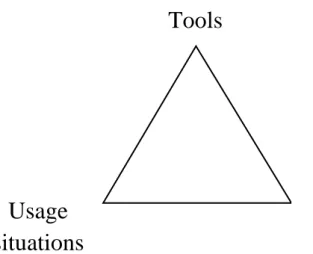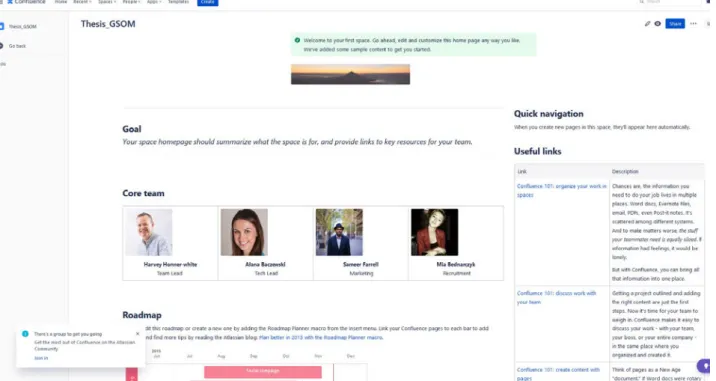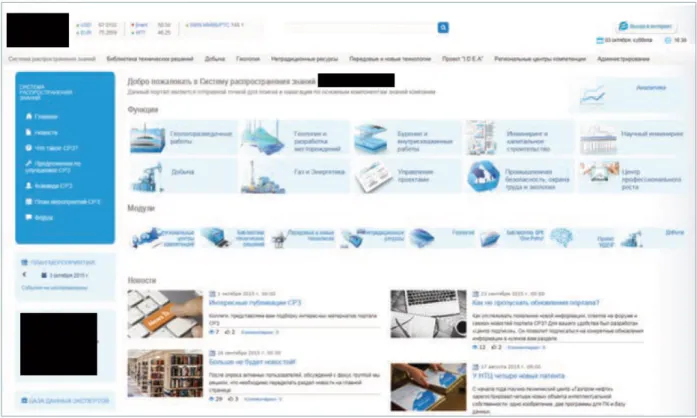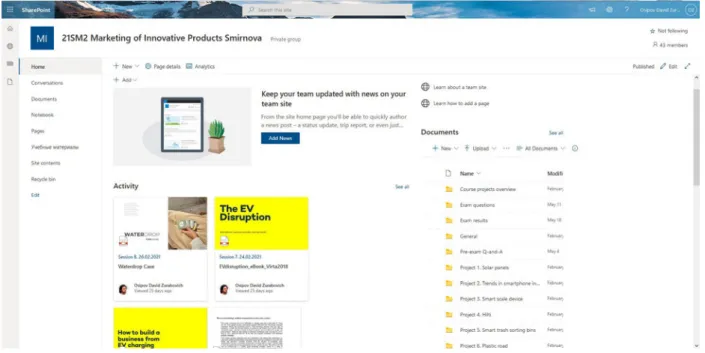The main research question of the study: "How can knowledge management tools be used in Russian enterprises to facilitate organizational learning?". The research question is "How can knowledge management tools be used in Russian enterprises to facilitate organizational learning?".
Key takeaways
Standard ISO 9001:2015 Quality management systems first introduced the importance of KM implementation. Developing an organizational infrastructure for the management of knowledge to serve relevant parties in the organization.
Knowledge management tools overview
Such cases make the definition of KM tools and finding a working piece of software/hardware very difficult, regardless of whether the information tool could serve as a KM tool at the same time. There are collaboration tools on the market such as Slack, Onenote, Dropbox, Yammer and others (Kukhnavets, 2019). In the reviewed scientific literature, there was no description of individual KM tools, only a general explanation of them (Centobelli et al., 2019), such as Web 2.0 blogs, Wikis, "data mining".
A good example would be – the KM tool for knowledge storage should be a No-SQL database in a back-end with a user-friendly front-end, used to store strategic knowledge documentation, presentations, cases, stories, project management best practices or any other. valuable knowledge of an organization. There is no such example in the scientific literature, confusing practitioners and making the field of KM scientific knowledge useless for them in this particular field. This should be done to refine the scope of the research, because in the case of "knowledge transfer" - any communication system, for example, instant messengers, e-mail services, would be considered possible KM tools.

Knowledge management processes and practices overview
It should not be a SQL database due to a wide variety of virtual knowledge formats. Whether a communication system plays a role in the KM process depends on the nature of the communication between two or more persons, and the analysis of KM processes is beyond the scope of this particular article. Strategic KM is concerned with the current and future strategic knowledge of the organization; building the organization based on a knowledge-based strategy; setting up activities for monitoring and measuring the knowledge assets in the company; and appreciation for their development needs related to the business environment.
Here, according to the authors, IT practices are very similar to the KM tools of the author of this research paper. There is a risk of outdated practices, but this is the only scholarly research available on cataloging KM practices at the time of writing. The author wants to encourage fellow researchers to investigate various knowledge management practices, as the most relevant research paper is from 2014, which poses the risk of using outdated information.
Key takeaways
In this paper, the author proposes to analyze only KM tools that deal exclusively with knowledge or knowledge + information that facilitate "knowledge sharing". Empirical study of KM tools used and scenarios of their use using ethnography and grounded theories. In the empirical part, the author wants to investigate individual problems of using KM tools that occur in actual companies.
However, this document also aims to present the use of KM tools "as is" in Russian companies; as a result, the author chose not to conduct controlled experiments, but to conduct exploratory case studies. Overall, the author wanted to get a glimpse of real-world usage scenarios, which would help build further theories about the efficiency of using KM tools. Another factor is that there is more practical relevance to industry in this study than a purely quantitative overview of the KM tools used.
Literature review sources selection
In order to obtain primary empirical data, a number of semi-structured interviews were conducted to discover KM tools and their use in Russian medium and large enterprises. This can be justified by the following reason: this study is exploratory because KM tools in use, user groups and usage scenarios need to be investigated and codified. A semi-structured interview approach was used to ensure the identification and use of KM tools to ensure maximum immersion in unusual scenarios of using KM tools.
However, this research is limited due to the increased workload and lack of free time to interview professionals due to the COVID-19 pandemic. Another is the tendency to ignore interview requests via communication systems, noted in the data collection section.
Empirical study sampling
Data collection
A brief overview of companies will be presented along with the KM tool overview they use. Afterwards, the user groups that use these tools and specific use cases will be described.
Companies overview
The company is headquartered in New York City, New York, USA (Summary | MarketLine Intelligence Center, 2021). The company has high ratings according to Russian credit rating agencies and the Moscow Stock Exchange. Company E is a vertically integrated oil company primarily engaged in oil and gas exploration and production, refining, and the production and sale of petroleum products.
The company provides real-time transaction data and proprietary analytics, data-driven consulting and marketing services. The company serves aerospace and defense; cars, chemicals; communications, media, technology; consumer products and retail; and utilities. Company H is an IT company specializing in Business Support System (BSS) and Internet of Things (IoT) platforms, primarily for telecom operators.
Results of the research
Confluence
The professional of company A is sure that if an experienced colleague leaves the company, his/her knowledge will not remain in the company. The professional of company B indicates that people in the company do not have such limitations as in company A. The professional of company B is also confident that knowledge retention in the company is relatively low.
The professional from Company G noted that the company saves presentations for clients and rarely best practices. Even the professional from company D said that he/she does not have enough free time due to the company's rapid growth and a high number of pending projects. The professional from company H stated that employees in his/her company use Confluence as KM tools for knowledge sharing and transfer.

Microsoft SharePoint
According to the professional from Company F, they created a wiki system in Confluence, but some sites transfer users to Sharepoint resources. Employees appreciate the seamless integration of the Microsoft ecosystem, but Knowledge is primarily stored in the Confluence application; communication, file sharing, and file collaboration are mostly done in SharePoint. On the downside, the professional pointed out that employees could not take advantage of the advanced search features in Confluence if a page in Confluence has few text fields and mostly links to MS SharePoint.
The professional shared a concern that only consultants update and maintain knowledge entries in Confluence; therefore, knowledge entries are created and updated irregularly after the project is completed, or knowledge entries are created and updated only once or twice. If the author of the knowledge entry has left Company F, a consultant can search for him/her in the Alumni network and interview him/her. The professional from Company F is therefore confident that his/her company is performing well as a learning organization.
Custom-built «Knowledge sharing system of the exploration and mining
In general, the knowledge library module is often used in the initial planning stages, including investment, and allows the preliminary calculation of the necessary value indicators for future oil deposits. Each section of the knowledge library module is systematically structured to contain guidelines for regulatory and methodological requirements for various mining activities. An important feature of the module is the involvement system in learning and knowledge exchange (gamification).
Android and iOS apps have been created to make the module easier to use. This KM system is deeply integrated with information management systems, thus enriching the capabilities of the KM system. The limitations of the theoretical work represent the limitations of the literature sources used, the literature review strategy, and the methodology.

Theoretical part contribution and impact
According to this paper, only company E meets the theoretical criteria for effective use of KM tools for knowledge sharing under the guidance of KM specialists. This particular article states that seven out of eight companies do not meet the theoretical criteria for effective use of KM knowledge sharing tools (taking into account research limitations). Petersburg University points to the fragmented use of knowledge management in Russian companies (Gavrilova et al., 2017) and complements this by presenting the use of KM tools and possible ways to improve the use of KM tools.
Furthermore, the experts did not share any unusual or company-specific uses of KM tools. The claim that knowledge management has a direct positive impact on organizational performance and, of course, financial performance has been noted by many studies by fellow researchers. These benefits would contribute to organizational learning through the implementation of a full set of knowledge management processes, the theoretically correct use of KM systems, and the employment of KM experts to facilitate the processes.
Empirical part contribution and impact
The claim that a poor understanding of what knowledge management actually is on the part of company employees, which can have a negative impact on organizational performance, still needs to be thoroughly studied by fellow researchers. This research paper attempted to propose the scientific community to adopt a commonly accepted terminology on knowledge management. It also attempted to investigate the use of KM tools in Russian companies and compare actual use with knowledge management theory.
The findings show that there is a probability of ineffective use of knowledge management tools, which potentially negatively affects the organizational performance of Russian companies. Ambiguity in terminology is likely to lead to confusion, lack of understanding, and ineffective implementation of knowledge management practices even in knowledge-intensive companies. There is great scope for further research in this area; the author suggests fellow researchers to more actively study the field of knowledge management, especially within the Russian context, to find out whether Russian companies effectively use knowledge management and help the business community by reducing confusion and helping them diagnose and fix common bad practices in the implementation and use of knowledge management.
Appendix 1. Interview Guide
How do you rate the quality of knowledge stored in the KM tools you use. The impact of knowledge sharing and innovation performance on the organization – moderated by innovation prices. Use of Knowledge Management Systems: Analysis of the Strategies of Brazilian Small and Medium Enterprises.
Using a systematic knowledge management-based system to optimize project management operations in oil and gas organizations.

